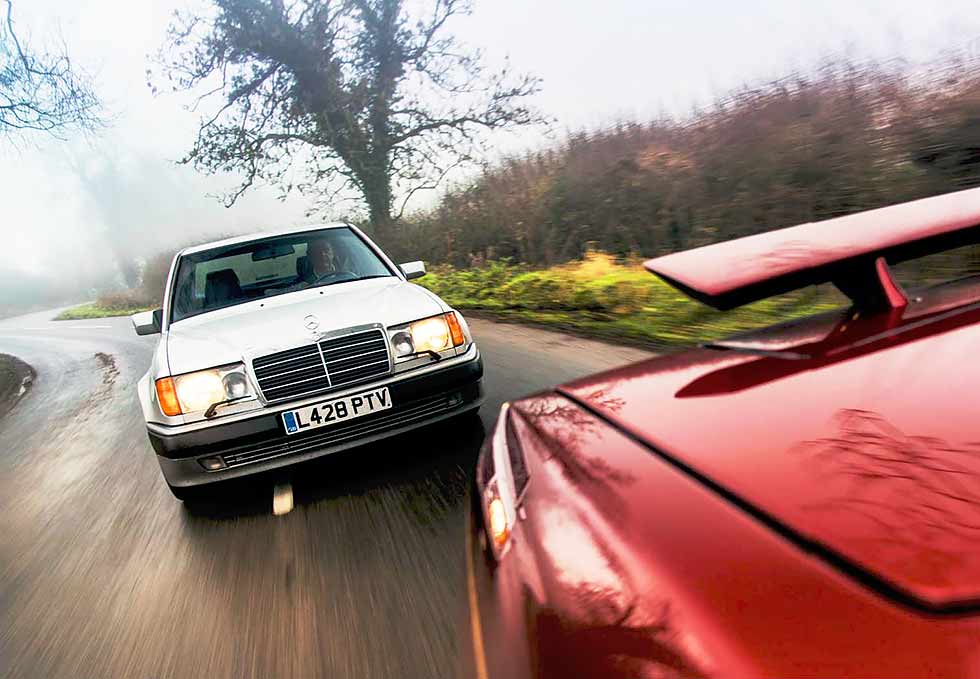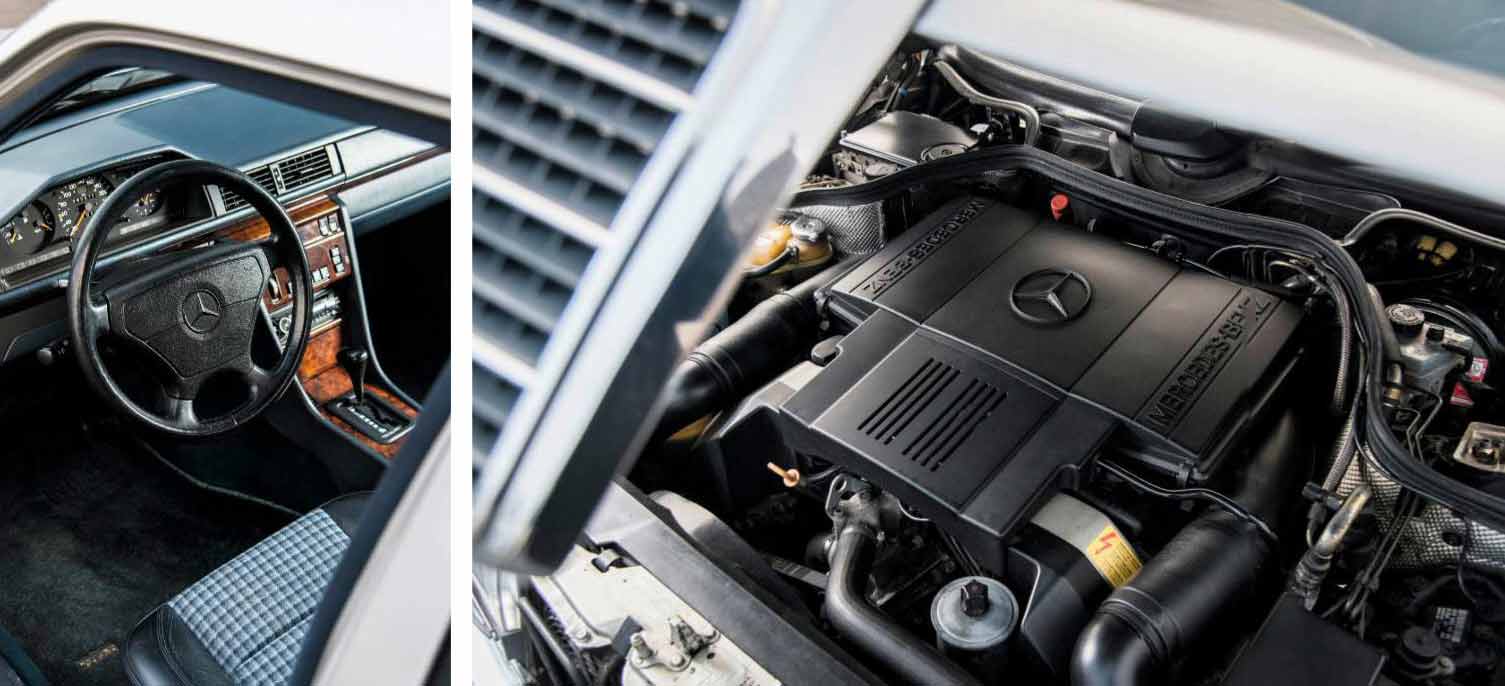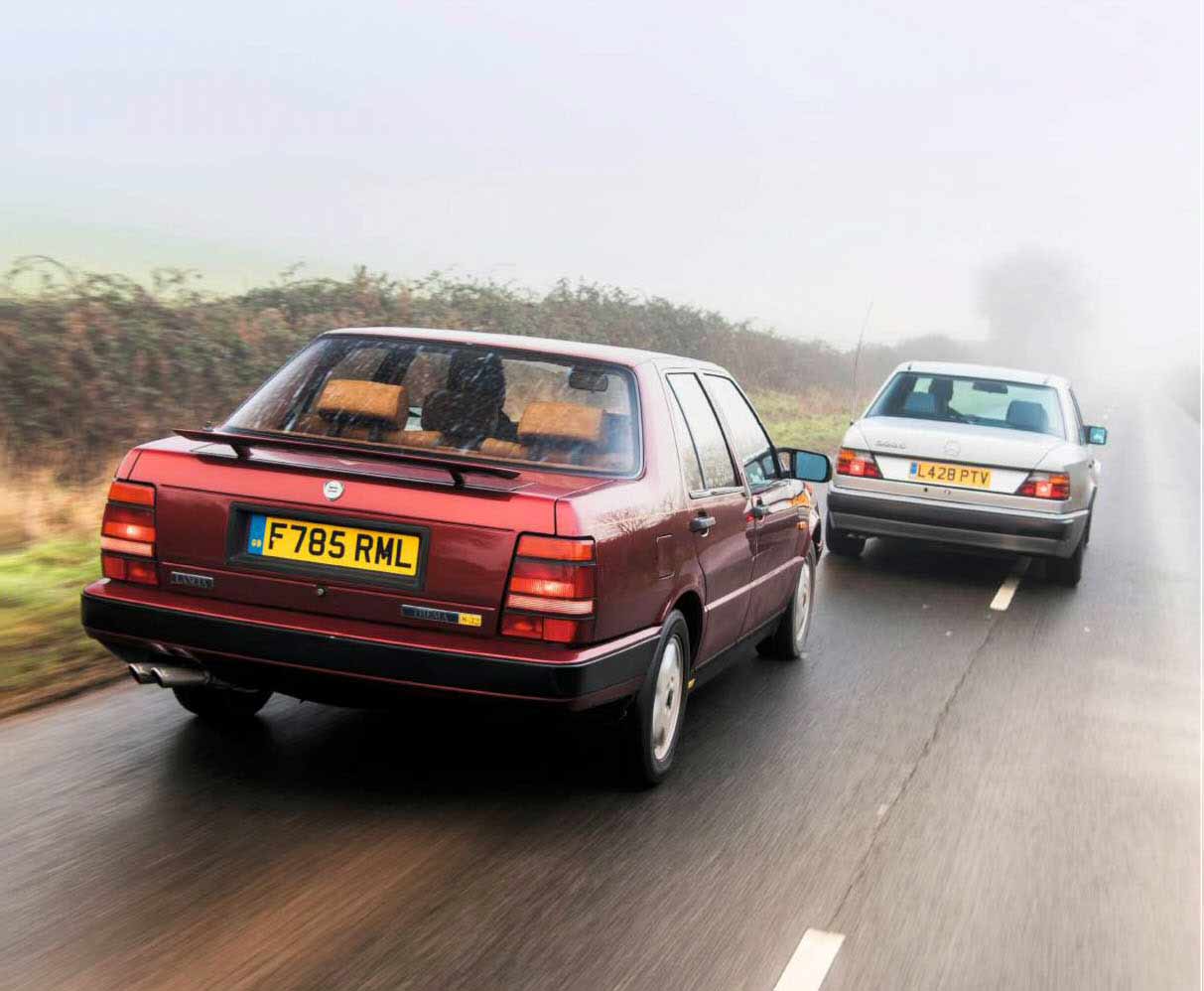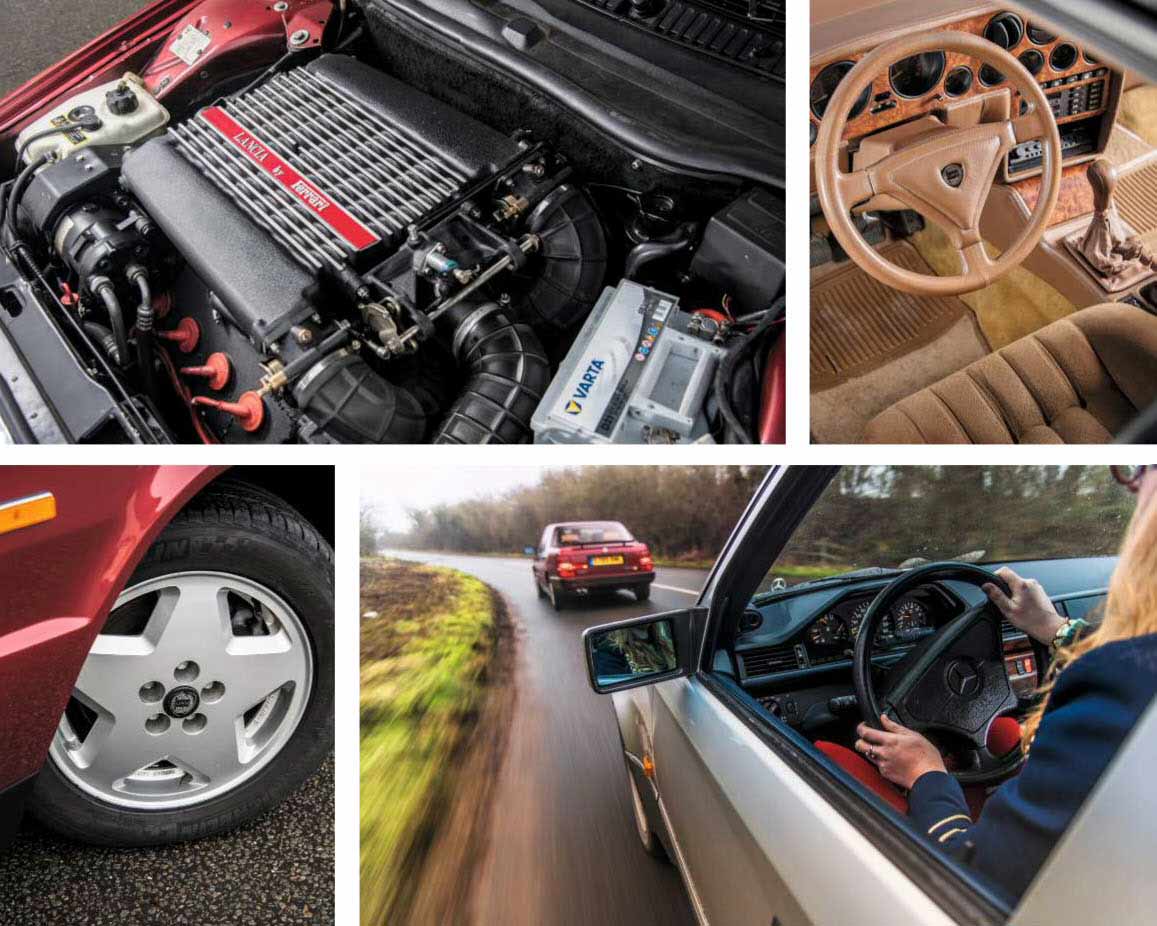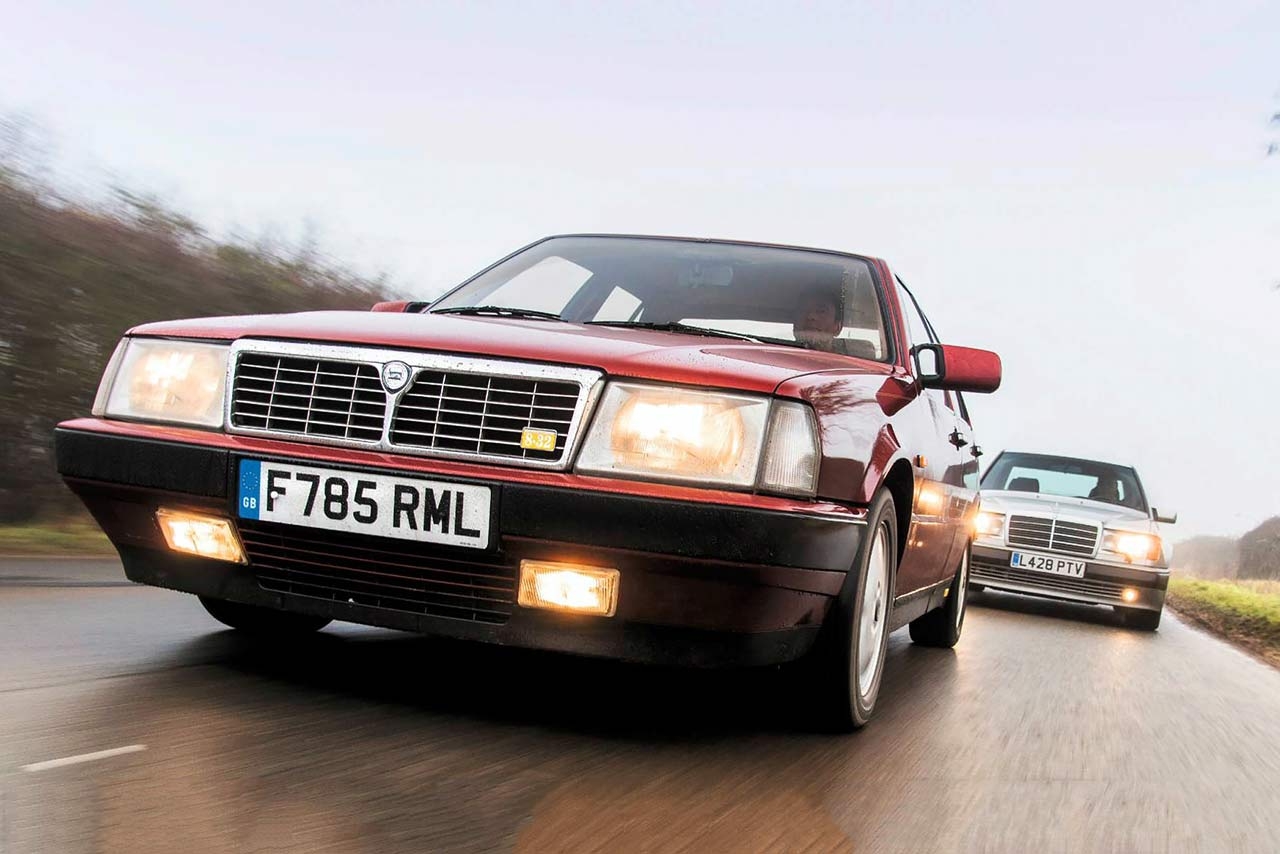
The Lancia Thema 8.32 and the Mercedes-Benz 500E W124 were so solemn for their era it wasn’t funny. But as we discover by going for a spin in this duo, owned by comedy legend Rowan Atkinson, straight-laced needn’t necessarily leave you straight-faced. Words Emma Woodcock. Photography Jonathan Jacob.
Double Act Comedian Rowan Atkinson explains the unique appeal of the Q-car as we drive two of his – a Lancia Thema 8.32 and Mercedes-Benz 500E W124 Rowan Atkinson’s Merc 500E and Lancia Thema 8.32 driven… …and you can buy them.
Back in the Eighties, when square, sharp styling was the in thing, rangetoppers did all they could to stand apart from the me-too mundanity of the average family car. Think of the Vauxhall Lotus Carlton and Ford Sierra RS Cosworth, a pair of modern classics that holler their intent with boxy arches, bonnet vents and high-rise rear wings. They’re lauded for looking lairy, and the same techniques were applied further down the food chain. GTis featured bright-red pinstripes and any number of MGs could be had with TURBO graphics down their flanks.
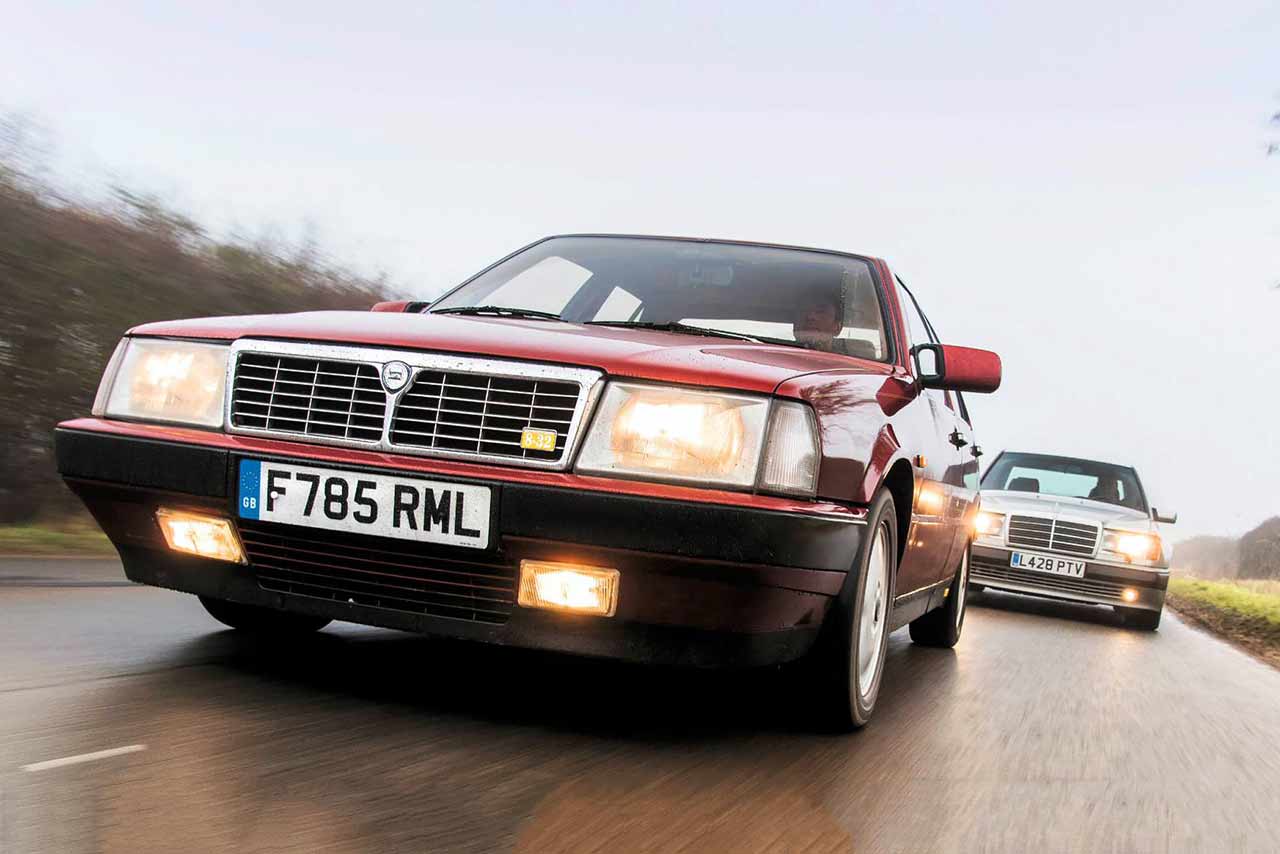
But there was a discreet minority; one that targeted the type who wanted to travel somewhere quickly but arrive there quietly. Perfect if, say, you’re an instantly recognisable TV personality who prefers to keep a low profile but demands a certain level of engagement from whatever you’re driving. Like comedian Rowan Atkinson, who owns the Lancia Thema 8.32 and Mercedes-Benz 500E W124 we’re going to be testing today.
The older of the pair of super saloons, the Lancia, was launched in 1986. Based on the Thema, the 8.32 took a conventional large saloon and added a Ferrari-based V8 with 215bhp. Not that you’d be able to easily tell from the outside. Model-specific changes included a hand-painted coachline, yellow 8.32 badging and deeper sideskirts but you’d need a trained eye to notice. The only obvious performance signifiers are six-spoke, 15-inch Speedline alloys, a pair of polished exhaust tips and the pioneering active boot spoiler.
If those alterations sound a little too brash for your tastes, you might want to consider a Mercedes-Benz 500E. Introduced in 1991, the 500 provided buyers with the first official route to a V8-powered W124 E-class, thanks to the 5.0-litre, 322bhp M119 motor from the R129 500 SL.
Again, most would struggle to notice. A 500E bootlid badge is the most obvious change, while the wellinformed might catch the eight-hole, forged 16-inch alloys, mildly flared wheelarches and revised front air dam with integrated foglights. A 23mm lower stance and a wider track also feature but the result is subtle. Lancia and Mercedes had created a new breed of high-class hotrod but it didn’t come easy – the 8.32 and 500E each required a convoluted production process.
For the Lancia, this meant having every part of the F105L engine cast at the Ferrari factory at Maranello before shipping the finished parts to Ducati for assembly. The engine was then transported to Lancia’s Turin production line to be fitted in the car itself. The process would be streamlined slightly for post-facelift, Series 2 cars, with engines still cast by Ferrari but assembled at Lancia’s own facilities.
The 500E production process was even more complex. Mercedes lacked the capacity to carry out full 500E assembly at its Sindelfingen plant and instead commissioned neighbour Porsche to complete some of the work. As a result, each car took 18 days to complete. Beginning life as a bodyshell on the Mercedes production line, each was then taken to the sports car manufacturer for strengthening. After the addition of extra bracing, extensive welding around the front and rear windows and a widened, strengthened transmission tunnel, a 500E would return to Mercedes for painting. A trip back to Porsche to fit the driveline, suspension and axles came next, before a final journey back to Merc for the addition of the interior and a final inspection.
The fact that respected car connoisseur Atkinson revisited both models after experiencing them new suggests that all that hard work was worth it – but it’s time to find out for myself. Get in and the 500E’s door closes with a thick thump. Everything is logically placed and most of it looks familiar. So far, so W124. Only a Sportline steering wheel, a wider transmission tunnel and a quartet of cloth-trimmed Recaro seats deviate from the norm.
As soon as you twist the key, there’s another difference to enjoy. The V8 settles straight to an 800rpm idle with an off-beat burble which resonates through the car. Threading through traffic, the steering is light, the ride comfortable and the brakes responsive. Were it not for the muscle car soundtrack, you could be in any executive cruiser. Don’t worry, there’s still a sporting spirit beneath the refinement, you just need a faster road to find it.
An empty A-road is the perfect place to get better acquainted. Leave the car in drive or third if you want respectable performance and an audible midrange burr; drop it into manualoverride second if you require eyebrow-raising pace and enough noise to wake half the county. Yeah, I went for second.
Start pushing into the throttle and the lengthy pedal travel makes you wait, then wait a little more, before anything happens. When it finally does, I know about it – the 500E squats low and the engine rises through a growling midrange to a metallic, high-pitched scream. The sound is textbook big V8 and, with a shortened, model-specific 2.82:1 final drive ratio, there’s flexibility to match.
Through gentle arcs, the 500E rolls a touch before settling and powering through. It’s pleasant but, in a car like this, a twisting minor road feels like the place to be. After all, the 500E was fitted with firmer, shorter springs, a wider track, thicker torsion bars and strut limiting springs for a reason. There’s plenty of grip, thanks to 225 section tyres all round. A 500 SL braking system, complete with 300mm front discs, should be good news too. The reality is much more mixed – they offer sharp feel and stop well at first but soon turn long and soft in even moderate road use, a criticism which could also be levelled at the Lancia’s anchors.
As the straights shorten and the bends tighten, the 500E shifts from accomplished to outright fun. The wide Recaro side bolsters are just firm enough to keep me in place and the low seating position creates an added sense of speed but they’ve got nothing on the steering, a recirculating ball system also lifted from the 500 SL. Turn in and the wheel bubbles to life, lightening and whispering delicate feedback into my fingers, while longer turns see the messages intensify and weight increase with the rising chassis load. Add a little power as the corner unfolds and the Mercedes leans into its outside rear tyre, yawing the whole car towards a tighter line. It’s a magical sensation and one that rewards smooth, considered driving. The 500E feels like it could take time to really unlock.
Over the same stretch of road, the Lancia offers similar thrills, packaged differently. Drop into second, push the throttle to the floor and the front rises as the steering wheel starts to twitch between my hands. Hit 3500rpm and the cabins fills with a fluty baritone that’s reminiscent of a flat-plane crank Ferrari. Reach 4500 and it shifts to a rounded bellow, like a larger-engined Mustang with the harsh edges sanded off.
The Thema is pulling hard now, having just reached its 210lb ft torque peak, but there’s more to be had. Fight the urge to upshift and head towards higher revs. Above 5000rpm the note changes again, the rounded sound gaining a gravelly, serrated undertone which rises in pitch and volume all the way to the redline. The complex note is thanks to the alterations Lancia made to the Ferrari V8 in pursuit of greater torque and smoother power delivery.
Major changes include a 90 degree non-planar crankshaft, a revised firing order and a complex two-into-one-into-two exhaust system.
Thanks to a short 3.41:1 final drive ratio, the Thema can thunder through second gear without coming close to the national speed limit. Time for an upshift. Depress the numb but weighty clutch and guide the leather-capped lever up into third. It’s a long shift but a beautifully analogue one, the weight below my palm ebbing from heavy to light and back to heavy as I find the next ratio.
Cornering is a less organic affair. Compared with a standard Thema, the 8.32 benefits from thicker springs, larger anti-roll bars, uprated wishbones and plenty more and, with the help of modern 205-section tyres all-round, there’s more than enough grip and traction if you approach the Lancia correctly. Smooth steering inputs generate nothing but lazy responses and I soon learn to turn hard and late to generate meaningful accuracy or feedback.
When I do, the steering turns from light to tight and heavy as the chassis loads up, telegraphing grip levels with minor fluctuations in steering weight. It’s an unorthodox feeling that requires an unconventional approach but master it and the Lancia feels like the world’s largest, most luxurious hot hatch. Tacking through corners in a zig-zag-zig of fast, flat turns, pushing further into the third-gear midrange whenever the road permits, the 8.32 is peculiar, unforgettable and addictive all at once.
There are advantages of taking it slow, one being the opportunity to enjoy the interior. Changes over other Themas included the leather-trimmed three-spoke steering wheel – fitted with a two-phase horn – walnut dashboard, deep-pile carpets and individually contained dials. The seats are different too as is the upholstery, which was available in leather or Alcantara. It’s overwrought and old school but, like so much else about the 8.32, it’s hard not to love.
Despite their obvious appeal, neither the Mercedes nor the Lancia would make much of an impact on the British market. Only 25 examples of the 500E were delivered to the UK, followed by just four post-facelift E500s, and a mere nine Series 1 Thema 8.32s – with mph speedos and units in gallons – would find their first home here. Though part of that can be attributed to the fact that both models were only ever offered in left-hand drive, the main problem was the list price. Why buy a Ferrari-engined Lancia when the same budget would secure a Ferrari-engined Ferrari?
Success might have been modest but these cars set precedents – the 500E foreshadowing a long line of AMG models and the Thema providing an engine-sharing concept that has since borne fruit for Maserati. But viewing them as a mere brand timestamp would be a gross injustice. These cars – the examples of which you see here will be sold in tandem at Silverstone Auctions’ Race Retro sale on February 24-25 – both possess an appeal that lies so deep it might even take a connoisseur more than one encounter to recognise and fully appreciate. Just ask the man who spent disproportionate sums maintaining these examples so that he could use them for the their original purpose – to be driven and enjoyed. If you can find him, that is.
Thanks to Nick Whale, Philip Day, the Lancia Motor Club, Neville Wright, Simon Harrison, the Mercedes- Benz Club and Silverstone Auctions
‘I buy classics for the way they feel, the way they drive – qualities that you can’t find in modern cars’
Rowan Atkinson decided to revisit a Mercedes-Benz 500E W124 similar to the one that he owned new, and a Lancia Thema 8.32 like the car he once test drove, so we asked him why he went back.
‘I’m fascinated by unusual cars, ones that other people don’t want. In the Eighties there were great numbers of them, often homologation specials and left-hand drive only.’
He bought a Mercedes-Benz 500E W124 in 1992, ‘The first time I drove it I thought how it had such alacrity, such lift. It was a wonderful car, very Teutonic and not exactly exciting-sounding – a bit Mercedes if you like. But it had superb ride, lots of go, it was comfortable, practical and excellent on long drives – a great all-rounder. And it was functionally discreet. That’s very appealing to me. What I grew to dislike about my McLaren F1 was the significance, the status of it.’

After regretting the sale of the 500E he bought the one seen here many years later. ‘I welcomed the simplicity of being able to go back to a car where the dash doesn’t light up and it doesn’t bing and bong at you.’ But finding a good example wasn’t easy.
‘A lot of them have rusted, and I wanted the cloth interior. Few UK cars were supplied with it. All of the cars available now are from Europe or Japan, which imported a tremendous number. It’s cool there to have left-hand drive. This one was a private sale and was already in London. It was in very good order and pretty low mileage – 80,000km I think.
He took it to the south of France in 2016, ‘With four people and their luggage it was deceptively quick, without fuss. I’d had it about a year but then my original car came up for sale. One guy had owned it for 24 years since I sold it, and he kept an amazing history of the car.’
Atkinson recalls how he considered buying a Lancia Thema 8.32 new but changed his mind after driving one. ‘I thought that it would be a bit more Ferrari-esque – anyone expecting that will be disappointed – but the 2.0 Turbo version was just as quick so I decided that it wasn’t the car for me.’
Despite that he decided to give the 8.32 another chance decades later, ‘I’ve had this one since 2010/2011 and I like it as a leftfield, eccentric choice. Unfortunately, the 8.32 was much harder to find in good condition than the Mercedes. Expensive upkeep and a car not worth much is a recipe for low-quality maintenance. So I tried to find one that hadn’t been used very much – you still have to have a lot of work done but hopefully the car won’t have rusted away. I think it had spent a lot of time in an underground car park in Chelsea Harbour, unused, but unloved. All of the dampers were seized.
‘So I spent an inordinate amount of money getting it in the order I wanted. For example, I went to a lot of trouble sorting out a vent in the climate control. It’s buried deep in the dash and two engineers wouldn’t even touch it for fear of what they might be getting themselves into, so I took it to Jim Stokes Workshops. The story behind the 8.32 appealed to Atkinson, ‘It’s a feat of production engineering – a V8 Ferrari engine shoehorned into a saloon. I like the odd, anorak facts, like the engine being built by Ducati.’
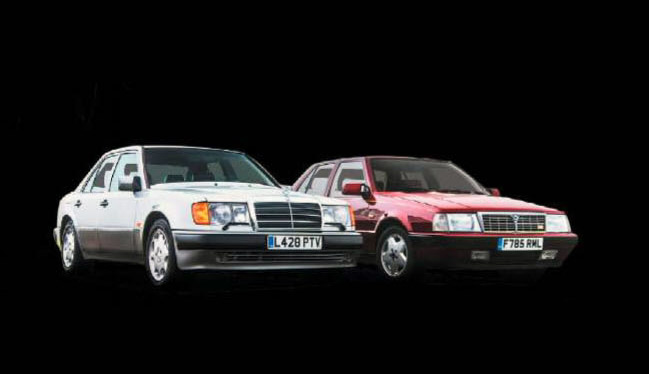
As with the Mercedes, it’s the way the Lancia drives, its capability, that sees him most animated, ‘I didn’t have all that much expectation of a £10k car but it’s a real pleasure – the way the engine is tuned and mapped makes it lazy and torquey at any revs, in any gear. It’s beautiful to drive, it sounds good, it feels good. And I enjoy the fact that that this one has Alcantara rather than leather, which goes hard and brittle with age.’
Once sorted he used the 8.32 as a practical long-distance cruiser. ‘I bought it to visit a friend’s house in the Alps near Geneva, so I found a set of new-old-stock wheels and fitted them with winter tyres. It’s amazing in the snow and wonderfully reliable – 1000 miles without any gip. I demand that of cars.
‘But life changes, I’m living somewhere different now and I don’t have the use for it or a convenient space to keep it. I got the best out of the car but now is the time for someone else to enjoy it.
If somehow I’m not getting enough use out of a car, it’s time to get rid. ‘There’s always that moment 18 months after I sell a car when I think, “Hmmm, it’s a shame I couldn’t just get in that and drive it.” But I think it’s important to move on and not get stuck with a narrow range of cars or one model. I’m a user, not a collector.’ Phil Bell
Tech and photos
TECHNICAL DATA FILE SPECIFICATIONS 1992 Mercedes-Benz 500E W124
Engine 4973cc V8, 32 valve, Bosch LH-Jetronic electronic fuel injection
Power and torque 322bhp @ 5700rpm; 354lb ft @ 3900rpm / DIN
Transmission Four-speed automatic, rear-wheel drive with optional limited-slip differential
Suspension Front: independent by MacPherson strut, coil springs and anti roll bar; Rear: independent by multi-link, coil springs and anti-roll bar with rear hydropneumatic ride level control
Steering Recirculating ball with hydraulic power assistance
Brakes Ventilated discs front, ventilated discs rear, servo assisted with ABS
Weight 1710kg (3770lb)
Performance Top speed: 155mph (limited); 0-60mph 6.0sec
Fuel consumption 16.5 mpg
Cost new £56,865
Classic Cars Price Guide £16,000 – £30,000
{module Mercedes Benz 124}
TECHNICAL DATA FILE SPECIFICATIONS 1988 Lancia Thema 8.32
Engine 2927cc V8, 32 valve, Bosch KE3 Jetronic mechanical fuel injection
Power and torque 215bhp @ 6750rpm; 210lb ft @ 4500rpm / DIN
Transmission five-speed manual, front-wheel drive
Suspension Front: independent by MacPherson strut, coil springs and anti roll bar; Rear: independent by MacPherson strut, coil springs and anti roll bar; optional electronically-controlled dampers Steering Rack and pinion with speed-variable power assistance
Brakes Ventilated discs front, solid discs rear with Bosch ABS system
Weight 1419kg (3128lb)
Performance Top speed: 149mph; 0-60mph 6.8 sec
Fuel consumption 16 mpg
Cost new £37,500
Classic Cars Price Guide £13,000 – £20,000
{module Lancia Thema}
